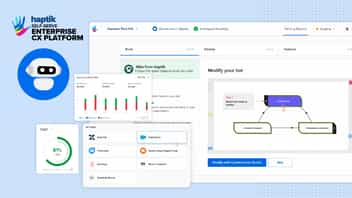Sentiment Analysis: Improve Virtual Assistant's Emotional Intelligence

While implementing virtual assistant solutions, there is understandably a great deal of emphasis on the intelligence of the solution. After all, it is essential for the assistant to know what the customer wants, and what it needs to do to fulfill that requirement.
However, to unlock the true potential of Conversational AI to deliver exceptional customer experience, it is also important for the assistant to also know how the customer is feeling while engaging with the business.
That’s where Sentiment Analysis comes in.
What is Sentiment Analysis?
-1.png?width=603&name=image%20(171)-1.png)
Sentiment analysis is broadly used as an umbrella term to describe technologies that seek to determine the emotion behind a customer’s message. It is a subcategory of Natural Language Understanding and Machine Learning - the technologies that give Conversational AI its ‘intelligence’ (NLU is what enables a virtual assistant to perceive and evaluate customer information, while ML improves a virtual assistant’s performance over time based on past conversational data).
Sentiment analysis is an added layer on top of a virtual assistant’s NLU engine which gives it the ability to decode the ‘mood’ of a user through analyzing speech patterns and sentence structure. To put it another way, Sentiment Analysis gives virtual assistants a kind of simulated ‘emotional intelligence’.
According to an Opus Research Survey, 72% of brands trust in sentiment analysis to enhance customer experience. A virtual assistant equipped with sentiment analysis can thus truly be a great addition to your brand’s CX arsenal.
How Sentiment Analysis Works
A Sentiment Analysis module is built by training an ML model on a large number of annotated sentences and their respective sentiments. Once the model is fully trained, it is able to classify live messages into one or more sentiments.
This is how a virtual assistant detects and interprets customer sentiment, step-by-step:
1. The virtual assistant detects the sentiment in the user’s messages and analyzes it for emotions like anger, frustration, sadness, happiness, optimism etc. Based on this, it can gauge if the mood behind the conversation is positive, negative or neutral.
2. Leveraging its NLU and ML capabilities, the assistant calculates the magnitude of these emotions, and puts a numerical score to them, as can be seen below:
.png?width=509&name=image%20(170).png)
3. Based on the outcome of the sentiment analysis, the assistant can take steps to drive the conversation in the appropriate direction. For e.g. if the score indicates a negative sentiment, then the assistant can transfer the conversation to a live agent, or execute tasks to mitigate the situation on its own and improve the customer’s experience.
How Sentiment Analysis Helps Brands Enhance CX
Course correcting in real-time
During the course of an interaction, a good customer service representative would be able to sense how engaged the customer and whether or not the conversation is going to their liking or not. Based on their assessment of the customer’s mood, they would adjust their responses or the tone of their communication in order to keep the customer in a positive frame of mind.
A virtual assistant with sentiment analysis capabilities can do the same thing - detecting the sentiment of the user and adjusting its responses or tone of communication accordingly. For instance, if the assistant detects that the user is angry or frustrated, it can modify its responses in order to calm the user down, and offer solutions to alleviate the situation by resolving the user’s issue.
The idea is for the virtual assistant to course correct in real-time based on the customer’s sentiment. If done right, this can turn negative or less than satisfactory customer experience into a positive one.
Facilitating handover to a human agent
Virtual assistants are great when it comes to handling routine customer interactions at scale. But the human touch is still essential, particularly when complex customer issues are involved. This is why many brands use an AI + Human hybrid approach to customer engagement - with a virtual assistant handling the bulk of interactions, while a human agent takes over for more critical conversations involving complex customer issues.
But how does a business decide which interactions to prioritize for escalation to a human agent? Sentiment analysis is one way to make that call. Customer interactions in which negative sentiment is detected can be prioritized for assignment to an agent, based on the magnitude of the negative assessment. So the more irate or angry the customer, the faster they will be auto-routed to a human agent for careful handling.
Evaluating customer care staff and improving processes
As we discussed, sometimes the human touch is indispensable when it comes to customer engagement. Which makes it essential for a brand’s human agents to be effective when it comes to handling angry or upset customers the right way, and solving their problems.
And how can brands evaluate that effectiveness? The answer to that question is - Sentiment Analysis.
When human agents use the Live Agent Chat dashboard of a Conversational AI platform to engage with customers, the platform’s sentiment analysis capabilities can provide real-time feedback on the agent’s ability to help customers who are having a negative experience.
The data gathered provides the business with valuable information when it comes to evaluating the overall performance of its customer care staff, as well as insights and learnings which can be used to train existing and new staff to better handle similar customer interactions.
Sentiment analysis in virtual assistants can also be leveraged by brands to identify aspects of their existing processes and practices that are contributing to poor customer experience and take corrective action. Virtual assistants serve as a goldmine of real-time consumer data, and through constant sentiment analysis on this data, businesses will be instantly alerted to negative feedback about their processes, and positive feedback about any improvements made.
Segmenting customers and measuring satisfaction
Sentiment analysis is a powerful tool for businesses to gauge the overall customer sentiment towards their products and services, as well as the prevailing customer perception of and attitudes towards their brand. This provides them with valuable insights on how customers feel about them, which in turn can shape their future approaches to customer engagement.
By analyzing conversational data gathered by the virtual assistant’s previous interactions with users, brands can segment customers based on their satisfaction levels and easily identify buckets of ‘unhappy’ or ‘demanding’ customers. Thus, customers with the most negative sentiment, who are at risk of churn, can be prioritized for more careful handling and detailed attention by customer care representatives, so as to avoid further negative sentiment.
Likewise ‘happy’ and ‘satisfied’ customers with positive sentiment can be identified, and rewarded and nurtured to build lasting brand loyalty.
Augmenting conversational commerce
Sentiment analysis can be a powerful aid to conversational commerce. A virtual sales assistant equipped with sentiment analysis capabilities can detect how well the conversation is going, and how the product/service recommendations it is making is being received by customers.
If it detects a positive sentiment on the part of the customer, it can double down on the same messaging and nudge the customer towards making a purchase. If it detects a negative sentiment, it can adjust its tone and messaging, or perhaps offer alternative product/service recommendations that might interest the customer instead.
What sentiment analysis essentially does is give Conversational AI the same ability to ‘read’ the prospective customer and gauge his/her reaction to a sales pitch that any good salesperson should have!
To sum up
.png?width=601&name=image%20(171).png)
According to a Microsoft report, 56% of customers globally have stopped doing business with a brand, or switched to a competitor, due to negative customer experience. This makes it crucial for brands to step up their CX game in order to boost retention and build long-term relationships with customers. Great customer experience is as much, if not more, about how a customer feels about your brand or your services as it is what they think. In this context, a virtual assistant equipped with Sentiment Analysis can certainly be a game-changer for your business!






















































